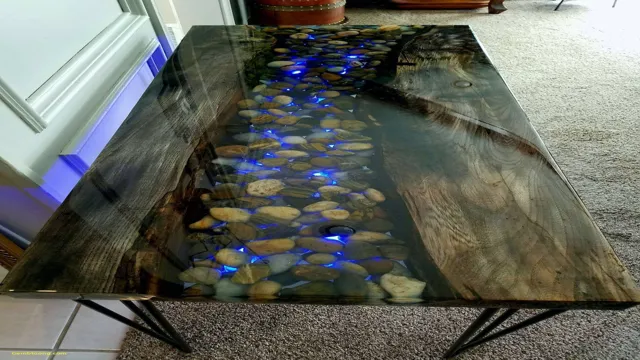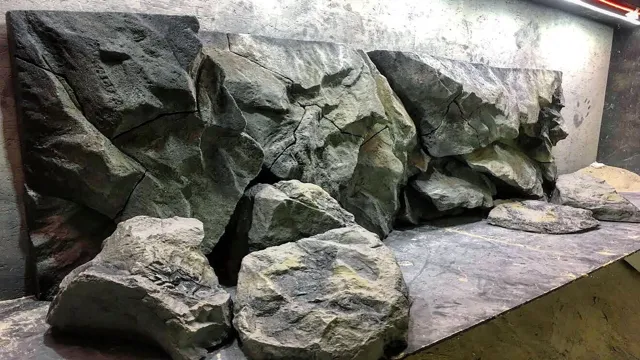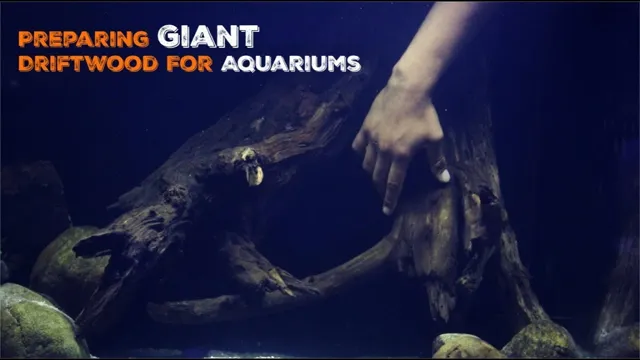How to Make Resin Aquarium Rocks: A Step-by-Step Guide for Stunning Aquascapes

Are you looking to add some unique decor to your aquarium? Why not try making your own resin aquarium rocks? These rocks not only add aesthetic value but also provide a great hiding spot for your fish. Resin is a versatile material that can be shaped and colored to mimic the look of natural rocks. Plus, it’s non-toxic and safe for your fish.
With some basic supplies and a little bit of patience, you can create your own custom rocks to add to your aquarium. In this blog post, we will guide you through the step-by-step process of making resin aquarium rocks. We’ll cover everything from gathering supplies to mixing and pouring the resin.
With our easy-to-follow instructions, you’ll be able to create aquarium rocks that look like they were plucked straight from your favorite fishing spot. So, what are you waiting for? Let’s dive in and get started on creating your very own resin aquarium rocks!
Gather Supplies
If you’re looking to create your own resin aquarium rocks, the first step is to gather your supplies. You’ll need a few key ingredients to make this project successful, including resin, a catalyst, and any pigments or dyes you’d like to use to color your rocks. You’ll also need some molds to shape your rocks, as well as some measuring cups, mixing sticks, and protective gear like gloves and goggles to keep yourself safe while working with resin.
Additionally, you may want to invest in a heat lamp or other tool to help cure your resin more quickly. By gathering all of these supplies ahead of time, you’ll be ready to dive into your resin rock project with confidence and creativity.
Resin, Catalyst, Rock Mold, Gloves, Mixing Cups, Stirring Sticks
If you are thinking about trying out resin crafting, you will need to gather a few basic supplies before you can start creating your first masterpiece. These supplies include resin, catalyst, rock mold, gloves, mixing cups, and stirring sticks. Resin is the main material used for crafting, and it comes in liquid form that hardens when mixed with a catalyst.
The catalyst is usually included with the resin, and it is used to speed up the hardening process. A rock mold is essential if you want to create resin rocks, pebbles, or boulders. Gloves are also a must-have item, as resin can be messy and hard to remove once it dries.
Mixing cups and stirring sticks are used to mix the resin and catalyst together in the correct proportions. It’s important to use the correct ratio of catalyst to resin to ensure that the resin hardens properly. Once you have all of these supplies, you’ll be ready to start exploring the many creative possibilities that resin crafting has to offer!

Prepare workspace
If you’re looking to create some stunning aquarium rocks, then you’ll need to prepare a dedicated workspace. This is especially important if you’re working with resin, which can be a messy material. Make sure you have a large enough area to spread out your supplies and work on your project.
You’ll need a flat, level work surface and a well-ventilated area to ensure that the fumes from the resin don’t build up. It’s also a good idea to have some protective gear, such as gloves and goggles, to keep your skin and eyes safe. Once you have your workspace set up, you’re ready to start creating your resin aquarium rocks! Remember to take your time with each step to ensure that your rocks turn out just the way you want them to, and always follow the manufacturer’s instructions for your specific type of resin.
Cover surface, have proper ventilation
When getting ready to tackle a DIY project, it’s crucial to make sure your workspace is properly prepared. One of the first things you should do is cover up any surfaces that could potentially get damaged or dirty during the project. This could mean laying down a tarp or plastic sheeting over the floor or using painter’s tape to protect trim and other surfaces.
Not only will this help keep your space cleaner, but it can also prevent damage to your home. In addition to covering surfaces, you’ll also want to make sure your workspace has proper ventilation. Depending on the project, this could mean opening windows or using a fan to circulate air.
This will help to keep you comfortable while you work and can also help to prevent the buildup of fumes or dust. By taking these simple steps to prepare your workspace, you’ll be in a better position to tackle your project successfully and without any added stress.
Mix resin
If you’re looking to create a stunning underwater world for your fishy friends, resin aquarium rocks can help you achieve your desired look. To make these rocks, you’ll need to mix resin thoroughly. Begin by preparing a well-ventilated area when working with resin as it can emit strong fumes.
Follow the manufacturer’s instructions for mixing the resin, as they vary by brand. Once mixed, combine the resin with your desired color dye or pigment to get the shade you want. Be sure to include enough dye or pigment to create the desired hue and allow it to harden completely before adding it to water.
Making resin aquarium rocks can be a fun and creative project that allows you to customize your aquarium’s aesthetic, adding depth and interest to your underwater world.
Follow manufacturer’s instructions, wear gloves
When it comes to working with resin, it is crucial to follow the manufacturer’s instructions. Resin can be hazardous if handled incorrectly, so it’s important to wear gloves and take all necessary precautions. One of the first steps in working with resin is mixing it.
To do this, you’ll need to combine the resin with the hardener in the correct proportions specified in the instructions. It’s essential to have a clean and measured workspace to ensure accuracy in the mixing process. Mixing resin may seem like a simple task, but there are important factors to keep in mind.
For instance, make sure to mix the resin and hardener thoroughly. You’ll want to use a stirring instrument slowly and consistently to avoid creating too many air bubbles in the mixture. Once you have the resin mixed, it’s important to use it promptly.
The resin will begin to set after a certain amount of time, and it’s important to get your project done before that happens. Remember that different types of resins may have different requirements when it comes to mixing and handling. It’s always best to read the instructions before starting your project and to make sure that you have all the necessary tools and equipment.
Ultimately, following these guidelines will ensure that your project is successful and that you’re able to work with resin safely. So go ahead, mix that resin, and make something amazing!
Pour resin in mold
One of the most interesting ways to add some flair to your aquarium decorations is by making your own resin rocks. The process is relatively simple, but it does require some careful attention to detail. To get started, you’ll need a mold (you can easily find these online or at a craft store), and some high-quality resin.
Once you have these materials, it’s time to get to work! First, you’ll need to mix the resin according to the instructions on the package. Be sure to mix it thoroughly to prevent any bubbles from forming. Then, pour the resin into the mold, making sure to fill it up completely.
You can add any colors or designs that you like at this point. Let the resin cure for several hours (or as instructed on the package), then carefully remove the mold. Your resin rock should be fully cured and ready to add to your aquarium! With a bit of time and effort, you can create unique and beautiful decorations that will make your aquarium stand out.
So, why not give it a try and let your creativity shine!
Fill to desired level, do not overfill
When it comes to pouring resin into a mold, one of the most crucial things to keep in mind is to fill to the desired level and not to overfill it. Overfilling can lead to a range of issues that can spoil the entire project. It’s essential to have a clear idea of the optimal level of resin to pour.
If you pour too little, you risk leaving gaps or empty spaces, leading to less than perfect end results. If you pour too much, the resin can spill or overflow, leading to a messy work area and a suboptimal finished product. The key is to carefully measure the resin and pour it slowly and steadily into the mold, ensuring that you achieve the desired level without any spillages.
So, whether you’re making a piece of jewelry, a decorative ornament, or any other resin-based project, be sure to pour the resin in slowly and carefully, filling to the desired level and not overfilling it. Doing so will help ensure that your project turns out exactly as you envisioned it!
Add colors and texture
If you’re looking to add some color and texture to your aquarium, making resin rocks is a fun and easy project to try. First, you’ll need to choose the colors you want to use and mix them into your resin according to the instructions. Pour the resin into a silicone mold in the shape of a rock, and then add in some texture by sprinkling some sand or small stones onto the surface while the resin is still wet.
You can even embed small plastic plants or other decorative objects into the resin for added interest. Once the resin has cured and hardened, you can pop the rocks out of the mold and add them to your aquarium. Not only do they add visual interest, but they also provide hiding spaces and climbing opportunities for your fish.
With a little creativity, you can create a stunning underwater landscape that your fish will love to explore. So give it a try and see what kind of unique designs you can come up with using your own artistic flair.
Stir in desired colors and add texture with tools or other materials
Now that you’ve got your clay all prepared, it’s time to add some colors and texture to it. There are plenty of ways to add some pizzazz to your clay creations! You can mix in some paint, glitter, or even food coloring. Just be careful not to use too much, otherwise, it could affect the consistency of the clay.
You can also experiment with different textures by using tools or adding other materials. For example, you can use a fork to create some lines or a toothbrush to create a splatter effect. You can even mix in some yarn or small beads to create a unique and interesting texture.
Just use your imagination and have fun with it! With some added color and texture, your clay creations will truly stand out.
Cure time
When creating resin aquarium rocks, the cure time is an important factor to consider. Cure time refers to the amount of time it takes for the resin to completely harden and become durable. This is typically affected by factors like temperature, humidity, and the type of resin used.
It is important to follow the manufacturer’s instructions when it comes to cure time to ensure that the finished product is safe for aquatic life. Generally, resin aquarium rocks take between 24-48 hours to cure completely. It’s essential to allow for sufficient cure time to prevent any potential harm to your fish.
Rushing the cure time could lead to the release of toxic chemicals that are harmful to aquatic life, leading to a disastrous outcome. Therefore, taking time and ensuring that the cure time has elapsed can save you a lot of trouble in the long run.
Follow manufacturer’s instructions, usually around 24-48 hours
“Cure time” One of the most important steps in any DIY project that requires the use of adhesive, sealant or coating is allowing ample cure time. While it may be tempting to jump right in and start using or handling your project as soon as you’re finished applying your chosen material, it’s important to resist the urge. Following the manufacturer’s instructions is crucial for maximum performance, and this usually means waiting around 24-48 hours before use.
The cure time is the period required for the material to reach its optimal strength and bond. Rushing this process can lead to unwanted results such as weak adhesion, poor performance, and even complete failure. By allowing the recommended cure time, a material will be able to reach its full potential and provide a reliable and long-lasting solution.
It’s important to plan ahead and give yourself enough time to complete the project with proper cure times in mind. Keep in mind that certain factors such as humidity, temperature and the type of material used can affect the cure time. So, before you start any project, read the instructions carefully and take the required time to ensure maximum performance.
Remember, patience is key when it comes to DIY.
Remove rocks from mold
When making resin aquarium rocks, one crucial step is to remove any existing rocks from the mold before pouring in the resin. This ensures that the final product comes out smooth and without bumps or imperfections. To remove the rocks, start by flipping the mold upside down and gently tapping it against a hard surface.
Avoid using too much force as this can damage the mold or compromise the integrity of the resin. If some rocks are still stuck, you can use a toothbrush or soft-bristled brush to loosen them and then tap the mold again. Remember to thoroughly clean the mold before pouring in the resin to prevent any dirt or debris from affecting the final product.
By taking your time and being patient, you can create beautiful and realistic aquarium rocks that will enhance the look of your tank.
Carefully remove rocks from mold, sand any rough spots
Removing rocks from the mold is a crucial step towards creating a flawless rock mold. One must be cautious while performing this task as rough handling can cause the rocks to break. It’s best to use a pair of gloves while doing this.
To remove the rocks carefully, you can start by gently tapping the sides of the mold and applying pressure to loosen the rocks. Make sure not to use excessive force as it can damage the mold. Once the rocks are out, check for any left-behind debris and remove it thoroughly.
After this, it is essential to sand any rough spots on the mold. Sandpaper with a fine grain can be used to smoothen down the mold surface. Be careful to not sand off too much material as that can alter the shape of the mold.
With this, you’ll have a rock mold that is ready to be used for various purposes such as creating structures, decorations, and jewelry.
Add to aquarium
If you are looking to add some creative flair to your aquarium, resin aquarium rocks are an excellent option. Making them yourself may seem like a daunting task, but it’s actually quite simple if you follow a few easy steps. Start by choosing the shape and size of your rocks, then mix the resin and hardener according to the manufacturer’s instructions.
Once the resin is thoroughly mixed, add in your desired colors and pour the mixture into your rock molds. Let them set for the recommended amount of time, then remove them from the molds and allow them to fully cure. Once cured, you can add them to your aquarium for a unique and personal touch.
With a little creativity and experimentation, you can create a stunning underwater landscape that your fish will love to explore. So why not give it a try and see what you can come up with?
Rinse rocks thoroughly and add to aquarium environment
When setting up an aquarium, it’s important to create an environment that’s suitable for your fish. One key aspect of this is adding rocks to the tank to create hiding places and add visual interest. Before adding the rocks, rinsing them thoroughly is an essential step.
This will remove any dirt or debris that could pollute the water and harm your fish. Once the rocks are clean, you can add them to the aquarium, taking care to arrange them in a way that looks natural and provides hiding spots. The rocks also provide a surface for beneficial bacteria to grow, which helps to maintain a healthy and balanced ecosystem in your tank.
By adding clean, well-placed rocks to your aquarium, you can create a beautiful and welcoming home for your fish.
Conclusion
In conclusion, the art of creating resin aquarium rocks is a wonderfully fun and unique way to spice up your fish tank. By following these simple steps and using your creativity, you can add a personal touch that your finned friends will love. Plus, with the added benefit of being incredibly durable and long-lasting, these rocks will keep your aquarium looking stunning for years to come.
So why settle for boring old gravel when you can sculpt your own underwater masterpiece? Get your supplies and dive right in – the possibilities are truly endless!”
FAQs
What materials do I need to make resin aquarium rocks?
You will need resin, a mold, dyes or pigments, and any additional decorations or embellishments.
How do I mix the resin for making aquarium rocks?
Follow the instructions on your resin package carefully. Generally, you will mix equal parts resin and hardener using specific measurements and stir for a predetermined amount of time.
Can I use any type of dye or pigment for coloring my resin rocks?
No, not all dyes and pigments are safe for use with aquariums. Make sure to use a dye or pigment that is specifically made for aquarium use.
How long does it take for the resin rocks to fully cure and be safe for my aquarium?
It can take anywhere from 24 to 72 hours for the resin to fully cure and be safe for use in your aquarium.
How do I remove any bubbles from my resin rocks?
Use a heat gun or torch to carefully remove any bubbles that may have formed during the mixing process.
Can I add glitter or metallic pigments to my resin rocks?
Yes, you can add any safe embellishments you desire to your resin rocks.
Is it safe to use multiple resin rocks in my aquarium?
Yes, as long as the resin rocks are properly cured and cleaned before being added to your aquarium, it is safe to use multiple rocks.






